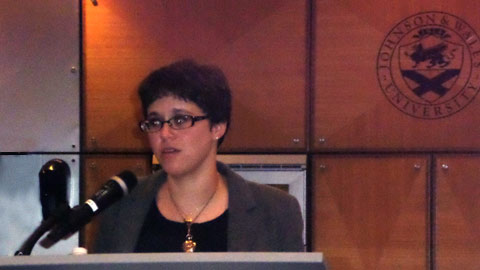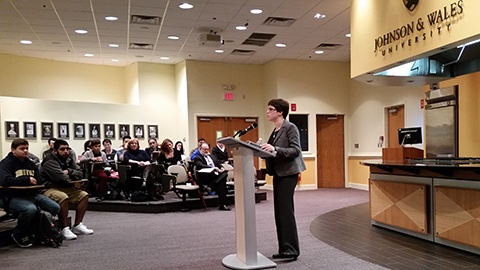Author Helene Wecker Speaks at JWU

“I can honestly say, this is the best smelling university I’ve ever spoken at,” said Helene Wecker as she greeted the packed HAC Amphitheater on October 28 for the second installment of JWU Providence’s 2015-16 Cultural Life Series. During a tour of the Harborside Academic Building before her presentation, Wecker found herself “pressing [her] nose against the windows of the classrooms,” watching the culinary students and recalling her own childhood culinary arts aspirations.
Wecker, author of ‘The Golem and the Jinni,’ grew up in Libertyville, Ill., a suburb of Chicago, and claims she was “a nerd out of the womb.” As such, she’s found herself drawn to the fantastical and has a strong interest in origin stories. “They allow you to see the things that make characters who they are,” she said.
To set the stage for those who were unfamiliar with her novel, she read two excerpts, one related to her female Golem character, and another related to the Jinni. She gave a brief explanation of the mythology traditionally related to both creatures.
These two characters, Wecker believes, are the most emblematic mythical creatures of her and her husband’s respective cultures (she’s Jewish and he’s Arab-American), and were developed in order to combine her love for the fantasy with her desire to share their families’ stories. What would eventually become ‘The Golem and the Jinni’ started as a short story Wecker was attempting to work into a collection she planned on submitting for her thesis in Columbia’s MFA program. After sharing her story with her MFA workshop, however, the group saw the work’s potential and encouraged her to turn it into a novel. “I was slowly becoming more and more invested in the work without even realizing it,” Wecker said.

As her master’s program was coming to a close, the novel still wasn’t finished. In order to obtain all the historical information she would need to complete the work, which she had decided would take place in New York City (the only plausible place a Golem and a Jinni could potentially run into one another, she argued) at the turn of the century, when thousands of immigrants were flooding through Ellis Island and into their respective cultural neighborhoods, she more or less “moved in” to the Columbia library.
Photocopying pages upon pages to schlep back across the country, Wecker not only had more than enough background to effectively and accurately describe the New York City of 1899, she discovered things she had never known about her own culture (what she called “different flavors of Judaism”) and immigrant neighborhoods that now no longer exist (many people asked her if Little Syria, a neighborhood of primarily Christian Arab-American immigrants that was located in what is now the Financial District, was something she had completely made up).
Wecker shared with the audience what the 7 years between when her Golem and Jinni first came into being and when Harper Collins purchased and published her book had been like— full of the frustration and failures that had initially deterred her from writing professionally in the first place. “I had this deep personal desire to say something,” Wecker said, “but I had to really focus on the craft of writing; of putting one word after another, after another, after another. And at some point it stopped being my book. It took on a life of its own.”
‘The Golem and the Jinni’ went on to win the Nebula Award for Best Novel, the World Fantasy Award for Best Novel, and the Mythopoeic Award, and Wecker recently announced she will be writing a sequel.
“I felt I wasn’t done with the characters,” she explained. “And they’re not done with me.”



